How to Build a Personal Learning Library from Any Document or Link
Imagine having all your learning materials—textbooks, articles, research papers, course notes, and web resources—organized in one searchable, visual library. No more lost PDFs, forgotten bookmarks, or scattered notes across different apps.
Building a personal learning library is one of the most powerful habits for lifelong learners, students, and professionals. Here's how to create yours using AI.
Why You Need a Personal Learning Library
A well-organized learning library helps you:
- Never lose important information - Everything in one place
- Study more efficiently - Quick access to visual summaries
- Build on previous knowledge - Connect new learning to old
- Review before exams - All materials organized by topic
- Share knowledge - Collaborate with teams and study groups
- Track your learning journey - See your progress over time
What Makes a Great Learning Library?
The best learning libraries are:
✅ Visual - Diagrams and slides, not just text
✅ Organized - Categorized by subject, topic, or goal
✅ Searchable - Find anything instantly
✅ Accessible - Available on any device, anywhere
✅ Shareable - Easy to collaborate with others
✅ Growing - Easy to add new materials continuously
How to Build Your Personal Learning Library
Step 1: Start Your Library Foundation
Go to https://www.miskies.app/miskies where your library will be hosted.
Click "Create New Miskie" to add your first learning material.
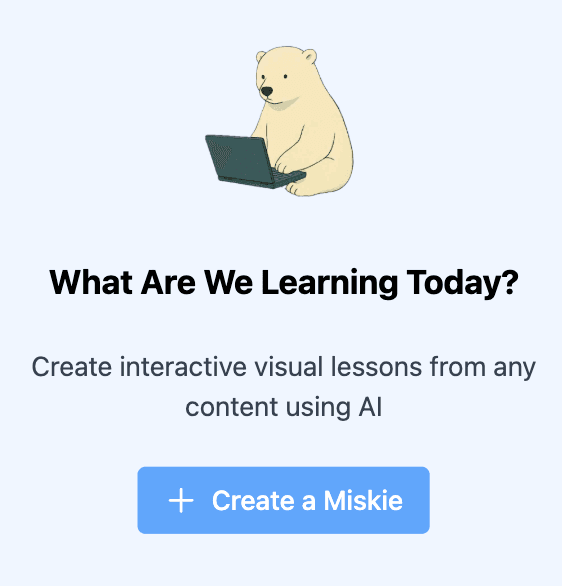
Step 2: Add Your First Learning Material
For each document or link you want to add:
Name it descriptively:
- "Quantum Physics Chapter 3"
- "Marketing Strategy Framework"
- "Python Programming Basics"
Define what you want to learn:
- "Understand quantum entanglement"
- "Learn customer segmentation methods"
- "Master list comprehensions"
Set time investment:
- How long you'll spend studying this material
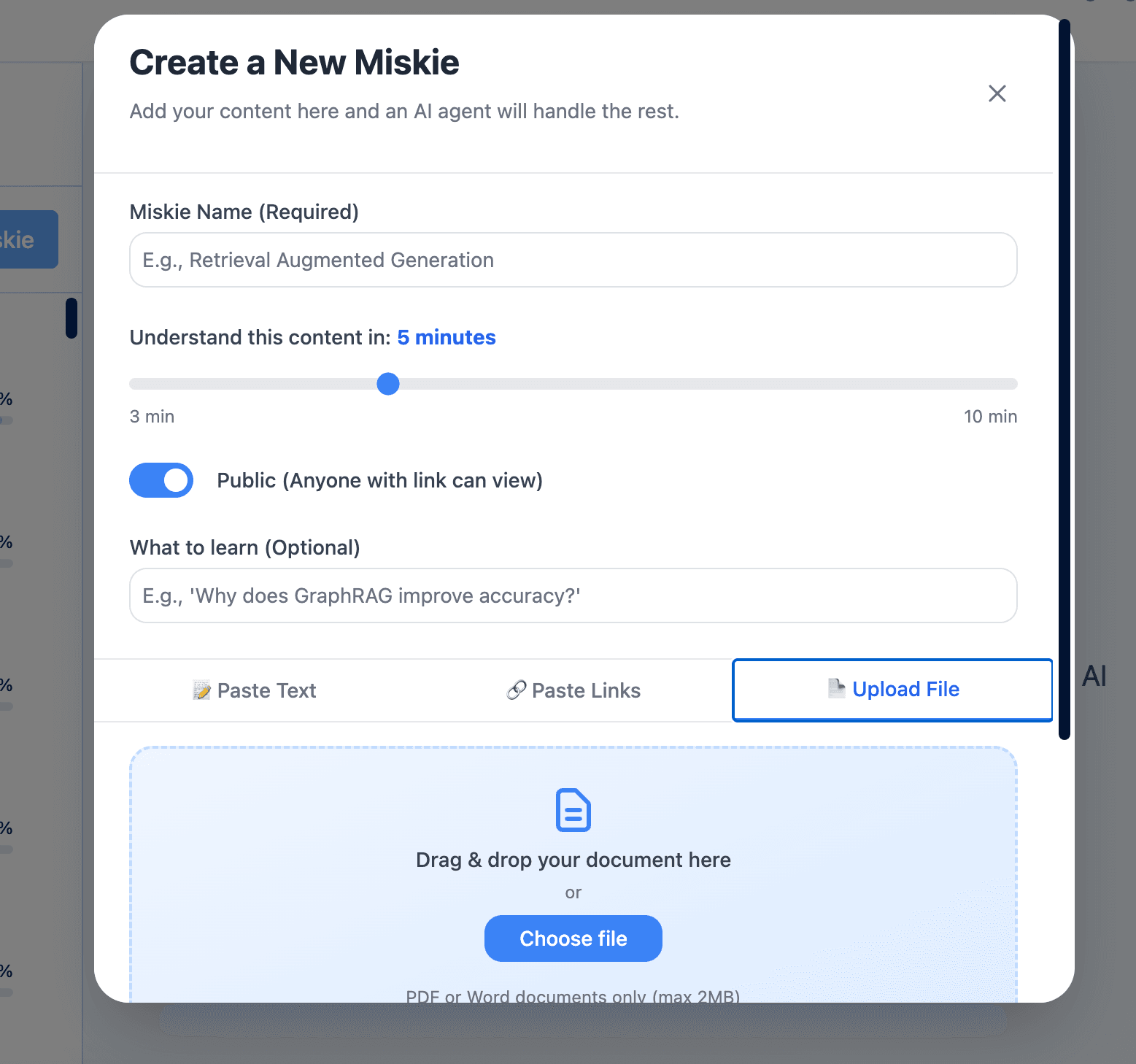
Step 3: Input Your Content
Your library can include any type of learning material:
Documents:
- PDF textbooks and papers
- Word documents and study guides
- PowerPoint presentations
- Course materials
Text Content:
- Lecture notes (paste directly)
- Article excerpts
- Study guides
- Personal notes
Web Links:
- Online courses and tutorials
- Blog posts and articles
- Documentation pages
- Educational videos (transcripts)

Step 4: AI Processes Into Visual Format
In 30 seconds, each library entry becomes:
Visual Slides with Diagrams:
- Pyramid diagrams for hierarchies
- Flowcharts for processes
- Venn diagrams for comparisons
- Sequence diagrams for timelines
- Scale diagrams for ranges
- Custom diagrams for your content
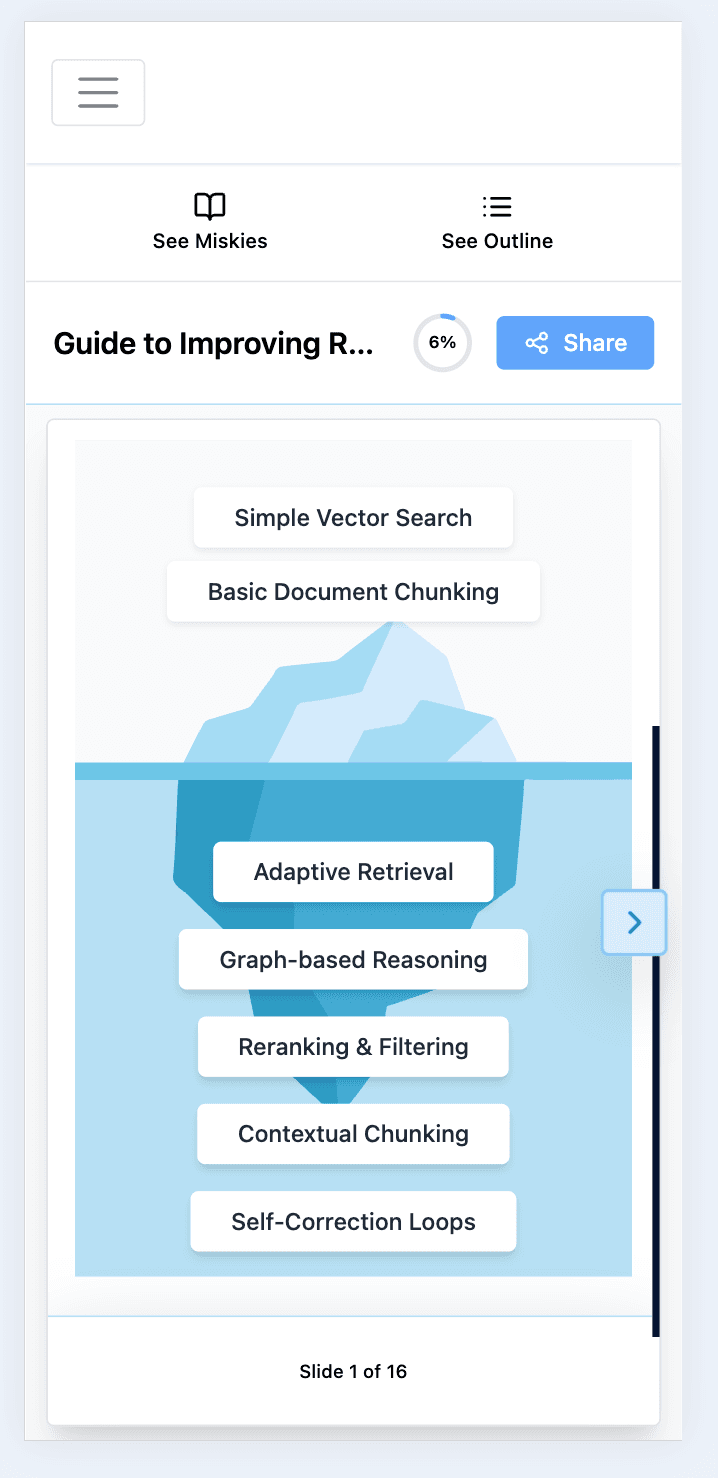
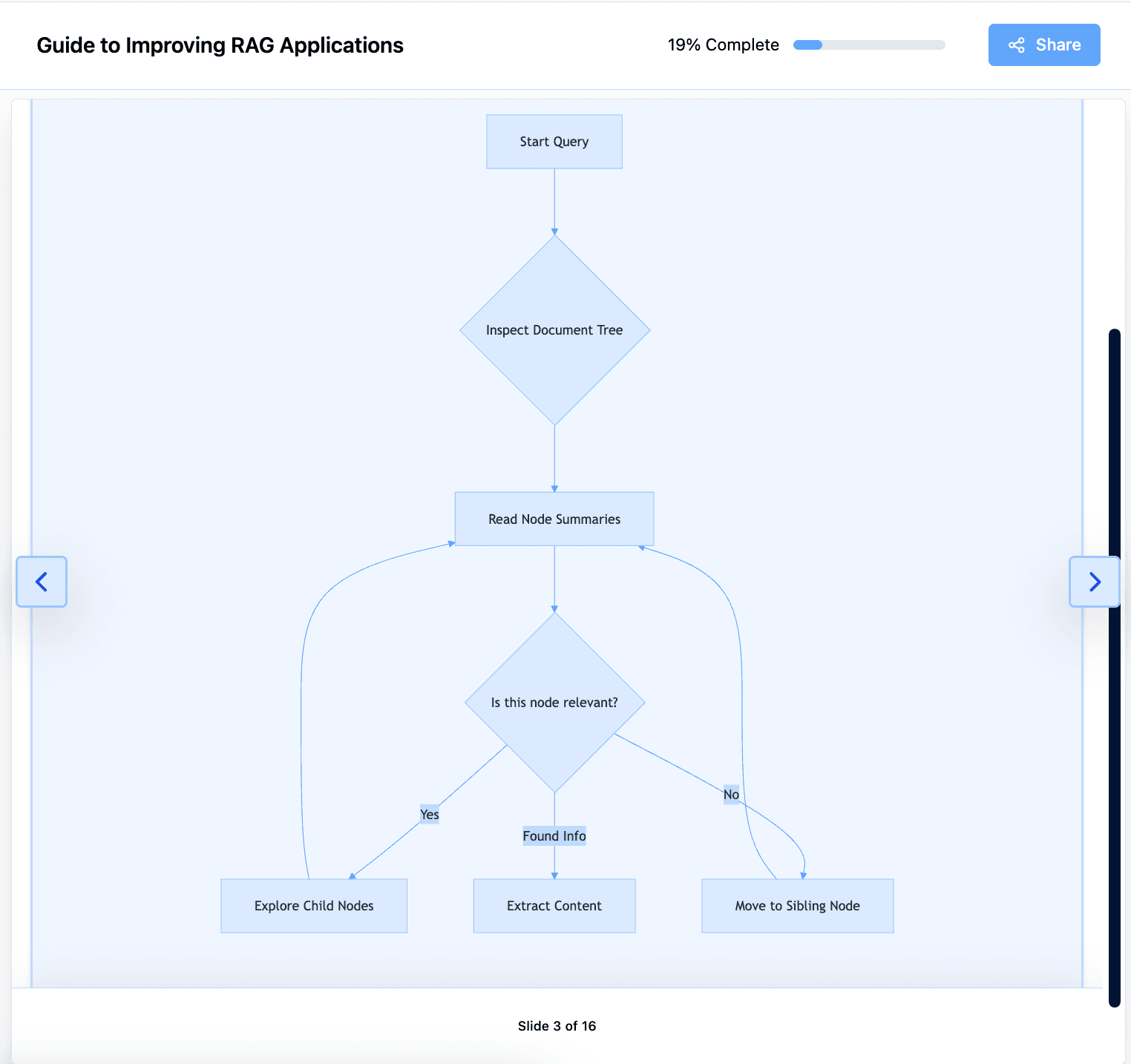
Interactive Learning Elements:
- Hands-on exercises
- Practice problems
- Quizzes and assessments
- Application scenarios
Step 5: Organize Your Library
All created materials automatically save to your library at: https://www.miskies.app/miskies
Organization tips:
- Create consistent naming conventions
- Group related materials together
- Add tags or prefixes (e.g., "BIO101-" for biology course)
- Prioritize by exam dates or importance
Building Library Sections by Subject
Science Library Section
Topics to include:
- Biology: Cell processes, anatomy, ecosystems
- Chemistry: Reactions, atomic structure, organic chemistry
- Physics: Mechanics, thermodynamics, electromagnetism
Document sources:
- Textbook chapters
- Lab reports
- Scientific papers
- Online tutorials
Business & Professional Library
Topics to include:
- Marketing frameworks
- Financial concepts
- Management strategies
- Industry reports
Document sources:
- Business books
- Case studies
- Market research
- Professional articles
Technology & Programming Library
Topics to include:
- Programming languages
- Frameworks and libraries
- Best practices
- Technical documentation
Document sources:
- Documentation pages
- Tutorial articles
- Stack Overflow guides
- GitHub repositories
Humanities Library
Topics to include:
- Historical events and periods
- Literary analysis
- Philosophical concepts
- Cultural studies
Document sources:
- Course readings
- Journal articles
- Primary sources
- Critical essays
Advanced Library Building Strategies
The Comprehensive Course Library
Create a complete visual library for entire courses:
- Add all textbook chapters
- Include all lecture notes
- Add supplementary articles
- Include practice exams
Result: Complete course reference in visual format.
The Topic Deep-Dive Library
Build expertise in specific topics:
- Gather multiple sources on one topic
- Create visual summaries of each
- Compare different perspectives
- Build comprehensive understanding
Result: Expert-level knowledge repository.
The Professional Development Library
Track your career learning:
- Add industry articles and trends
- Include certification materials
- Save conference presentations
- Document best practices
Result: Career growth knowledge base.
The Research Library
Organize academic research:
- Add research papers you're reading
- Include methodology documents
- Save data analysis guides
- Reference theoretical frameworks
Result: Organized research foundation.
Enhancing Your Library Over Time
Daily Learning Habit
Add 1 new piece of content daily:
- Morning: Add article you read
- During class: Add lecture notes
- Evening: Add study material
30 days = 30 visual learning modules
Weekly Review Sessions
Every week:
- Review new additions
- Re-study older materials
- Identify gaps in knowledge
- Add materials to fill gaps
Monthly Organization
Once per month:
- Reorganize by priority
- Archive completed courses
- Highlight exam-critical materials
- Clean up naming conventions
Continuous Expansion
Always be adding:
- New textbook chapters
- Interesting articles
- Professional resources
- Community recommendations
Sharing Your Library Content
Make learning collaborative:
Share Individual Items:
- Generate public link for specific materials
- Share via email or messaging
- Post to study group chats

Discover Community Libraries: Browse public learning materials: https://www.miskies.app/miskies/explore
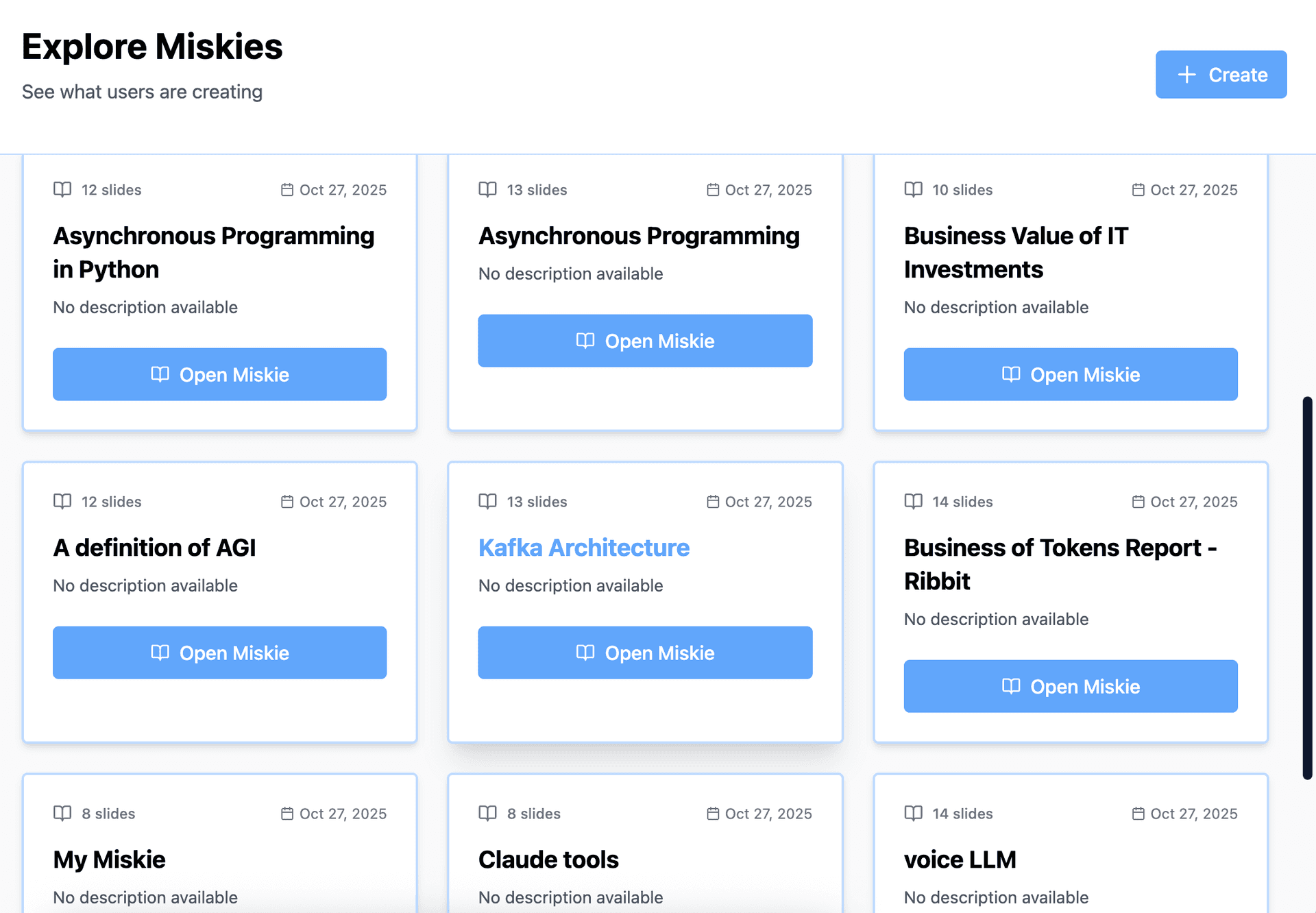
Benefits of sharing:
- Help classmates and colleagues
- Get feedback on your understanding
- Discover new resources
- Build learning communities
Using Your Library Effectively
Before Class or Meetings
- Review relevant library materials
- Refresh your memory on key concepts
- 5-minute quick review
During Study Sessions
- Deep dive into specific topics
- Complete all exercises
- Test yourself with quizzes
Before Exams
- Review all course materials in library
- Focus on visual diagrams for memory
- Identify weak areas for extra study
For Work Projects
- Reference relevant professional materials
- Apply frameworks and concepts
- Share with team members
Real-World Library Examples
Medical Student Library
Contents:
- Anatomy visual guides
- Physiology process diagrams
- Pharmacology summaries
- Clinical case studies
Result: Complete medical school reference.
Software Developer Library
Contents:
- Programming language references
- Algorithm visualizations
- Design pattern guides
- API documentation summaries
Result: Technical knowledge at fingertips.
MBA Student Library
Contents:
- Business framework diagrams
- Case study analyses
- Market research summaries
- Strategy models
Result: Business knowledge repository.
Self-Learner Library
Contents:
- Online course materials
- Tutorial articles
- Book summaries
- Skill-building exercises
Result: Lifelong learning portfolio.
Benefits of a Visual Learning Library
Compared to Traditional Methods:
Scattered PDFs and Bookmarks:
- ❌ Hard to find what you need
- ❌ No visual summaries
- ❌ Can't review quickly
- ❌ Difficult to share
Miskies Learning Library:
- ✅ Everything in one searchable place
- ✅ Visual diagrams for every concept
- ✅ Quick 5-minute reviews possible
- ✅ Easy sharing with one link
Library Maintenance Tips
Keep It Current
- Add new materials regularly
- Remove outdated information
- Update as you learn more
Name Consistently
- Use clear, searchable names
- Include course codes or categories
- Add dates if relevant
Review Regularly
- Revisit old materials monthly
- Reinforce long-term memory
- Discover new connections
Backup Your Learning
While Miskies saves everything automatically:
- Download important materials
- Export links you share
- Keep original source documents
Start Building Your Library Today
Don't let valuable learning materials remain scattered and disorganized. Build a comprehensive personal learning library that grows with you.
Visit Miskies AI and add your first learning material in 30 seconds.
Free Forever • Unlimited Storage • Access Anywhere • Share Easily
Your future self will thank you for building this knowledge foundation today.
Keywords: personal learning library, knowledge management, digital learning library, organize study materials, learning resource library, build knowledge base, visual learning library, student knowledge management, professional development library, organize course materials